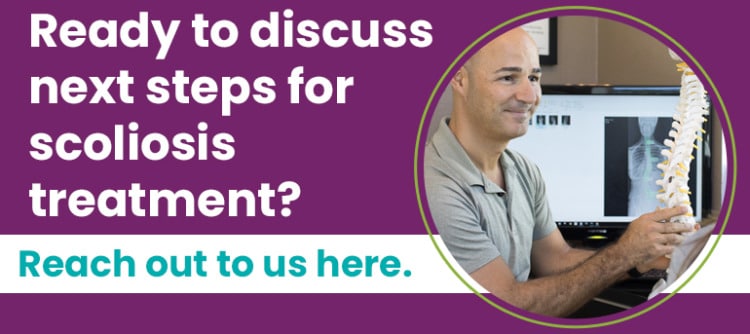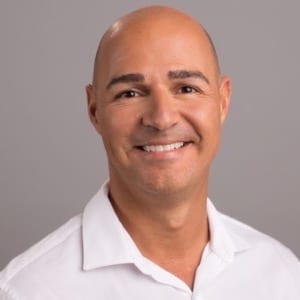What Does Scoliosis Come From? Causes and Origins
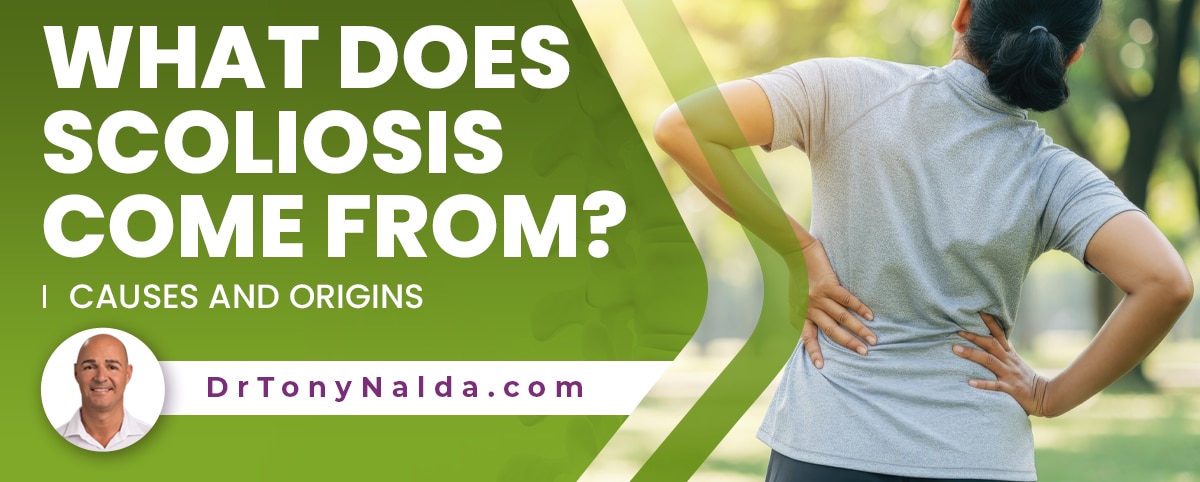
Scoliosis isn't contagious; it's not something a person can catch, and it's also not considered a genetic condition, so where does it come from? Despite scoliosis first being documented in ancient times, there is still a lot we don't know about the progressive spinal condition, but we do know how to treat it effectively.
With close to seven million people living with scoliosis in the United States alone, many of them children, a lot of studies have been devoted to causation. While most cases are idiopathic, some types are associated with known causes: neuromuscular, degenerative, and congenital.
As different types of scoliosis have unique causes, let's start by exploring the different types of scoliosis and what we know about their causation.
Table of Contents
Scoliosis Causation
Knowing the cause of a condition can help with treatment because addressing an underlying cause is the best way to improve the condition itself, along with its symptoms.
But what happens when we don't know why a condition develops? This is the case with the most-prevalent form of scoliosis: idiopathic scoliosis.
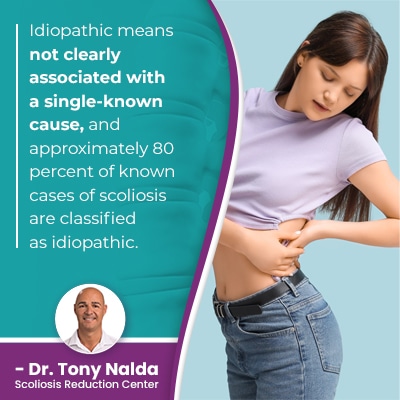 Idiopathic means not clearly associated with a single-known cause, and approximately 80 percent of known cases of scoliosis are classified as idiopathic.
Idiopathic means not clearly associated with a single-known cause, and approximately 80 percent of known cases of scoliosis are classified as idiopathic.
Idiopathic scoliosis is thought to be multifactorial: caused by a number of factors, or a combination of factors, that can differ from one patient to the next.
There have been a number of theories regarding these factors ranging from low body mass to hormone deficiencies to issues related to bone and muscle health.
Regardless of why scoliosis develops, all types can benefit from early detection, if followed by proactive treatment plans.
Early Detection
The most common type of idiopathic scoliosis overall is adolescent idiopathic scoliosis diagnosed between the ages of 10 and 18.
As adolescents are the most at risk for rapid advancement due to the rapid and unpredictable growth spurts of puberty, this is the age group that can benefit from early detection the most, particularly if treatment is started prior to the first pubescent growth spurt.
Early detection means conditions are diagnosed while still mild, when curves are small and the condition's effects are subtle; this is the best time to start treatment, but early detection isn't always easy.
Idiopathic scoliosis is also the main type to affect adults, and these cases are mainly pre-existing from adolescence but were undiagnosed and untreated, highlighting the importance of early detection.
By the time these adult patients come in to see me, they have already experienced significant progression, and had they been diagnosed and treated during adolescence, it's possible the progression may have been preventable.
The lack of pain in scoliosis patients who are still growing accounts for the main challenge to early detection of adolescent idiopathic scoliosis; if left untreated, it can become adult idiopathic scoliosis.
This is why even a diagnosis of mild scoliosis should be taken seriously because that doesn't mean there is more time to act; without treatment, childhood scoliosis can become adult scoliosis that's compressive and painful.
It's important for patients and parents to understand how important treatment is, and how beneficial early intervention can be, and it's natural for parents whose child is recently diagnosed to ask if the condition was passed down genetically, and this has a complex answer.
Is Idiopathic Scoliosis Genetic?
As the leading spinal condition among school-aged children, a lot of time and effort has been expended in the search for a genetic explanation behind the development of scoliosis.
In order for a condition to be officially classified as genetic, a specific gene, or genetic combination, has to be located, and that has yet to be identified.
As mentioned, idiopathic scoliosis is thought to be multifactorial, and remember, families share a lot more than just their genes; they share common responses to stress, socioeconomic factors, geographical location, body type, lifestyle, diet, and more.
There have also been a number of twin studies that further complicate the topic as there are cases of twins both developing scoliosis, or cases where one twin does and the other doesn't, or cases where each twin develops a different type of scoliosis.
The fact that studies show a higher concordance for the genetic argument in identical twins versus fraternal twins could suggest there are some genetic factors at play, so while there do appear to be some heritability factors, the mode of inheritance remains unclear.
So now that we have fully explored the nature of idiopathic scoliosis in terms of what triggers its initial onset, let's discuss condition types with known causes.
Types of Scoliosis with Known Causes
As mentioned, 80 percent of scoliosis cases don't have known causes, but the remaining 20 percent are associated with known causes: neuromuscular scoliosis, degenerative scoliosis, and congenital scoliosis.
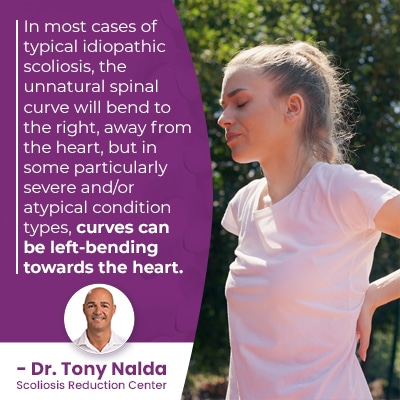 In most cases of typical idiopathic scoliosis, the unnatural spinal curve will bend to the right, away from the heart, but in some particularly severe and/or atypical condition types, curves can be left-bending towards the heart.
In most cases of typical idiopathic scoliosis, the unnatural spinal curve will bend to the right, away from the heart, but in some particularly severe and/or atypical condition types, curves can be left-bending towards the heart.
To diagnose scoliosis, an X-ray is needed, and when I see a left-bending curve on an X-ray, this is a red flag that there is an underlying pathology involved, and the condition is likely to be severe with unique treatment needs.
Neuromuscular Scoliosis
Neuromuscular scoliosis is caused by the presence of a larger neuromuscular condition like spina bifida, muscular dystrophy, and cerebral palsy.
While not every neuromuscular condition will cause scoliosis, it is a common complication as these disorders cause a disruption between the brain, the spine, and the muscles and connective tissues that provide the spine with support and stability.
Cases of neuromuscular scoliosis tend to be severe, with some patients becoming wheelchair-bound and unable to walk on their own.
These cases are complex, atypical, and severe, and this complicates the treatment process as the underlying neuromuscular condition has to be the focus of treatment.
Degenerative Scoliosis
Degenerative scoliosis affects older adults (45+) and is caused by natural age-related spinal degeneration.
The cumulative effect of certain lifestyle factors can also play a role in an adult's level and rate of spinal degeneration: carrying excess weight, leading a sedentary lifestyle, chronic poor posture, excessive consumption of alcohol and/or smoking, and or repeatedly lifting heavy objects incorrectly and straining the spine and its surrounding muscles.
Most degeneration in the spine starts with the intervertebral discs. The spine consists of vertebrae stacked on top of one another in a straight and neutral alignment, and adjacent vertebrae are separated by an intervertebral disc.
Adjacent vertebrae attach to the disc in between, so if a disc is degenerating, becoming desiccated, and changing shape, it can affect the positioning of attached vertebral bodies, and this can cause them to shift out of alignment with the rest of the spine and an unnatural spinal curve to develop.
Most cases of degenerative scoliosis are progressive and painful due to the spine's increasing instability.
Congenital Scoliosis
Cases of congenital scoliosis are rare, affecting 1 in 10,000, and babies are born with the condition due to the spine not forming properly in utero.
Congenital scoliosis can be caused by the spine's vertebrae failing to form into separate and distinct bones, instead becoming fused together and causing the spine to develop an unnatural curve, and vertebral bodies that are more triangular in shape can cause the spine to wedge forward during formation, disrupting its alignment.
So scoliosis can also be caused by the spine not forming properly.
Conclusion
When it comes to understanding scoliosis and treatment efficacy, it's important to remember that as a progressive condition, it can change over time.
And while we don't always know why scoliosis develops initially, over the years, we have learned a lot about scoliosis and how it responds to different facets of treatment.
When it comes to idiopathic scoliosis with no known cause, these are typical cases, and while there are never treatment guarantees, with early detection and intervention, these cases may be highly treatable.
When it comes to scoliosis with known causes, these types tend to be more severe and complex to treat, but remember, these only account for 20 percent of diagnosed cases; in many cases, scoliosis can be highly treatable, particularly with early detection and intervention.
Here at the Scoliosis Reduction Center®, the goal is to restore the spine's alignment and increase the spine's surrounding muscle strength for more support.
Chiropractic care can work towards repositioning the curve's most-tilted vertebrae, and physical therapy and scoliosis exercises can help improve the spine's surrounding muscle strength and balance, and particularly for addressing childhood scoliosis, corrective bracing can be applied to augment these results by improving posture.
Dr. Tony Nalda
DOCTOR OF CHIROPRACTIC
After receiving an undergraduate degree in psychology and his Doctorate of Chiropractic from Life University, Dr. Nalda settled in Celebration, Florida and proceeded to build one of Central Florida’s most successful chiropractic clinics.
His experience with patients suffering from scoliosis, and the confusion and frustration they faced, led him to seek a specialty in scoliosis care. In 2006 he completed his Intensive Care Certification from CLEAR Institute, a leading scoliosis educational and certification center.
About Dr. Tony Nalda
 Ready to explore scoliosis treatment? Contact Us Now
Ready to explore scoliosis treatment? Contact Us Now